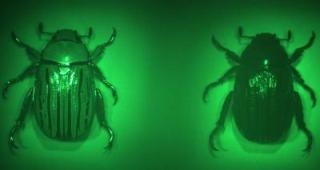Jun 24 2016
The natural world has several objects that are geometrically chiral. It is not possible to superimpose chiral objects onto their mirror image. For instance, human hands are mirror images, and so transplanting the right hand onto the left would be ridiculous. Amino acids, DNA and certain other molecules are said to be chiral.
 Imaging with the multispectral chiral lens forms two images of the beetle, Chrysina gloriosa, on the color camera. The left image was formed by focusing left-circularly polarized light reflected from the beetle and the right image was formed from right-circularly polarized light. The left-handed chirality of the beetle's shell can clearly be seen. (Image courtesy of the Capasso Lab/Harvard SEAS)
Imaging with the multispectral chiral lens forms two images of the beetle, Chrysina gloriosa, on the color camera. The left image was formed by focusing left-circularly polarized light reflected from the beetle and the right image was formed from right-circularly polarized light. The left-handed chirality of the beetle's shell can clearly be seen. (Image courtesy of the Capasso Lab/Harvard SEAS)
Light can possess the chiral effect. In chiral light, the oscillation direction of the electromagnetic wave termed as polarization rotates counterclockwise or clockwise. Based on the nature of chirality of the molecules present in a material, light tends to bounce off these materials differently.
For instance, artificial sweetener Aspartame has chirality. One chirality of the molecule is bitter and the other is sweet. Likewise drugs too can be chiral. One notorious instance of chirality is the Thalidomide molecule. One version of the molecule caused terrible birth defects in thousands of children while the other acted as a sedative to pregnant women.
Therefore, it is crucial to monitor and investigate an object’s chirality in several fields. But existing chiral imaging methods used for resolving spectral (color) data and polarization need several cascading components, which causes the equipment to become bulky and expensive.
A team of researchers from the Harvard John A. Paulson School of Engineering and Applied Sciences (SEAS) have built a highly compact flat lens with the ability to concurrently trap the chirality of an object as well as the spectral data.
The details of the study were published in Nano Letters.
For the first time, chiroptical properties can be probed across the entire visible spectrum using only a single planar lens and a camera without the addition of other optical components. We have demonstrated the potential of metalenses in realizing a compact and multifunctional device with unprecedented chiral imaging capabilities.
Federico Capasso, the Robert L. Wallace Professor of Applied Physics and Vinton Hayes Senior Research Fellow in Electrical Engineering, and senior author of the paper.
The lens comprises two arrays of titanium oxide nanofins on a single glass substrate, which develops two images possessing opposite chirality.
The green and blue nanofins focus left-circularly polarized light and right-circularly polarized light, respectively, and exhibit the images next to each other. To show the lens’s efficacy, the researchers imaged a beetle’s chiral exoskeleton. The right image was created from right-circularly polarized light, and the left image was created by aiming left-circularly polarized light reflected from the beetle. It was possible to clearly view the left-handed chirality of the beetle’s shell.
The lens is also capable of showing when an object is not chiral, such as a one dollar coin, which tends to reflect right and left circularly polarized light in the same manner.
The size of the lens is a major feature, said Wei Ting Chen, a co-author of the paper and postdoctoral fellow in the Capasso Lab.
The chiral lens is very compact, only 3mm in diameter and thinner than hair, allowing us to integrate it into portable devices.
Chen.
Our work is an unprecedented demonstration of a multifuntional metasurface. We showed that an ultrathin surface can both form an image and simultaneously resolve both polarization and spectral information of a biological specimen.
Reza Khorasaninejad, a postdocteral fellow in the Capasso Lab and first author of the paper
The coauthors of the paper are Alexander Zhu, Jaewon Oh, Robert Devlin and David Rousso of SEAS. The Air Force Office of Scientific Research, Thorlabs, and Draper Laboratory supported the research. This research was performed in part at Harvard University’s Center for Nanoscale Systems (CNS), a member of the National Nanotechnology Coordinated Infrastructure (NNCI), which is supported by the National Science Foundation.